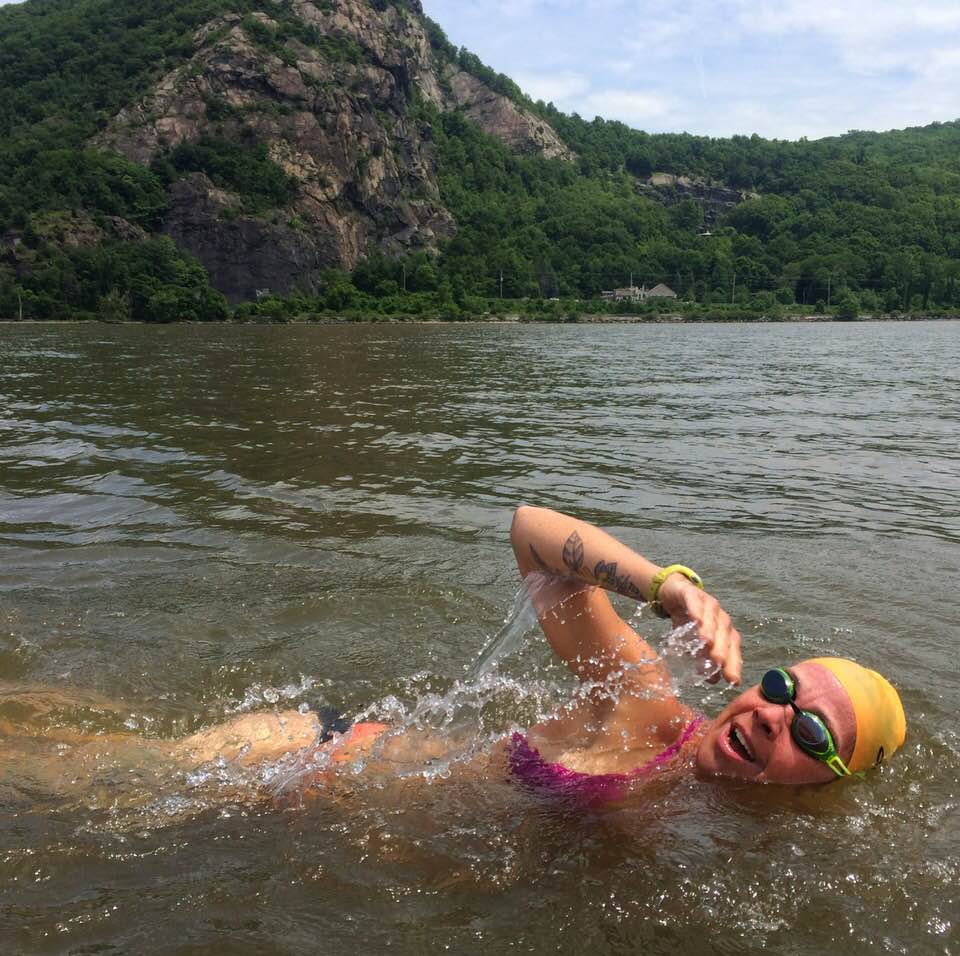By Rondi Davies. Photo credits: Janet Harris, Sharon Gunderson, Courtney Moates Paulk.
Reverse Manhattan Swim History
Kris Rutford was the first to swim a Reverse Manhattan in August, 1995 in a time of 17:48:30. Liz Fry completed the swim on September 18, 2009 in a time of 11:44:05 with a start and finish at the Willis Avenue Bridge in the Harlem River.
Planning
I’ve been fascinated by the Reverse Manhattan swim since I followed Liz Fry’s swim, and it’s been a goal to attempt it for a few years. However, since becoming a parent it hasn’t been possible for me to train enough to realistically attempt any marathon swim.
Courtney Moates Paulk has been eager to try the Reverse swim with NYOW; her persistence was the push I needed to find a date, commit, and get somewhat prepared (I wasn’t going to organize this swim and not try it myself). After hiring coach Abby Fairmain last December, I had put in a minimal amount of pool training and a good number of marathon swims during the summer (8 Bridges Stages 0, 2, 5, 6 and Kingdom Week days 1,2,3 including an 18 mile double crossing of Lake Massawippi in Quebec).
I chose Sunday, September 1 for the fast tidal currents (which are needed to get up the Hudson) and warm water. September 28 offered a faster tide, but cooler water. Plus New York City closes its pools for maintenance after Labor Day, so I would miss valuable pool time in the lead up. In addition, September 1 worked best as I just started a new job, the kids are headed back to school, and lawyer Courtney had a big court case coming up.
Model
Andrew Malinak and I independently prepared models for the swim. Considering my open water pace (of 3.45 km/hr with feeds and waves) determined from my recent Vermont swims, we both predicted a time of 8 hours 44 minutes. Our models matched almost exactly for the different locations on the course, which usually doesn’t happen when we model the counterclockwise 20 Bridges swims. I was excited the swim could be so fast and was mentally preparing for a nine-hour, record shattering swim.
The swim would start with the Hudson flood, so the current is building and peaking as we reach the George Washington Bridge, about 12 miles upriver. After four hours in the Hudson, swimmers enter the Harlem in the dying flood and are confronted by the ebb current several miles later. I calculated this to be around the Madison Avenue Bridge, five miles into the Harlem. Then swimmers must fight the ebb current until Mill Rock, spending a total of 3.5 hours in the Harlem River.
At Mill Rock swimmers join the fast (up to 5 knots) outgoing ebb of the East River. The goal would be to work hard for the first seven to eight hours to be sure to make the most of the Hudson and Harlem flood currents. In the Harlem, we were to hide from the ebb on the sea wall to make progress. Once in the of the East River the water would be with us and we could relax and almost float to the finish.
My head space
Life is busy so there wasn’t a lot of time to mentally prepare. NYOW hosted a 16-swimmer 20 Bridges swim the day before (8/31), so I was caught up in that, but at least not on the water. I told NYOW co-founder David Barra the swim was almost an academic exercise in mastering the currents in the reverse format, and trying for a record swim time as a bonus. The stakes were low, since the swim was almost an experiment, and so my anxiety levels were reasonably low. Andy bought my feeds while I worked the swim on Saturday. I threw everything in a bag the night before, but in my scattered state forgot to give Andy my teams contact info.
The Team
We met at Pier 40 just before the 6 AM sunrise. My team consisted of crew person Janet Harris, observer Dana Page, and kayakers, Luis Lopez and Alex Arévalo. Janet is a good friend and accomplished and experienced marathon swimmer. Dana is marathon swimmer and exceptional volunteer for NYOW (also a paramedic and public defender). She delayed her trip back to DC after 20 Bridges the previous day to observe my swim. Alex and Luis have done 12 swim support circumnavigations of Manhattan this season alone and were excited to see the swim in reverse. Having two kayakers felt decadent, but it was an immeasurable help once we were fighting the current in the Harlem.
We chatted with Courtney and her crew Liz Fry, the Reverse record holder, and busily prepared before loading the RHIBs. Pat Kerrigan and Terry Lopatosky as kayaker and observer rounded out Courtney’s team. Janine Serell was at the dock to wish us well and helped set the tone for a relaxed and fun day. “Remember that these are your home waters” were her words of wisdom before we parted. Sean Makofsky, Thomas Crystall and Rick piloting RHIBs arrived and we motored to the Staten Island Ferry Terminal at the southern tip of Manhattan.
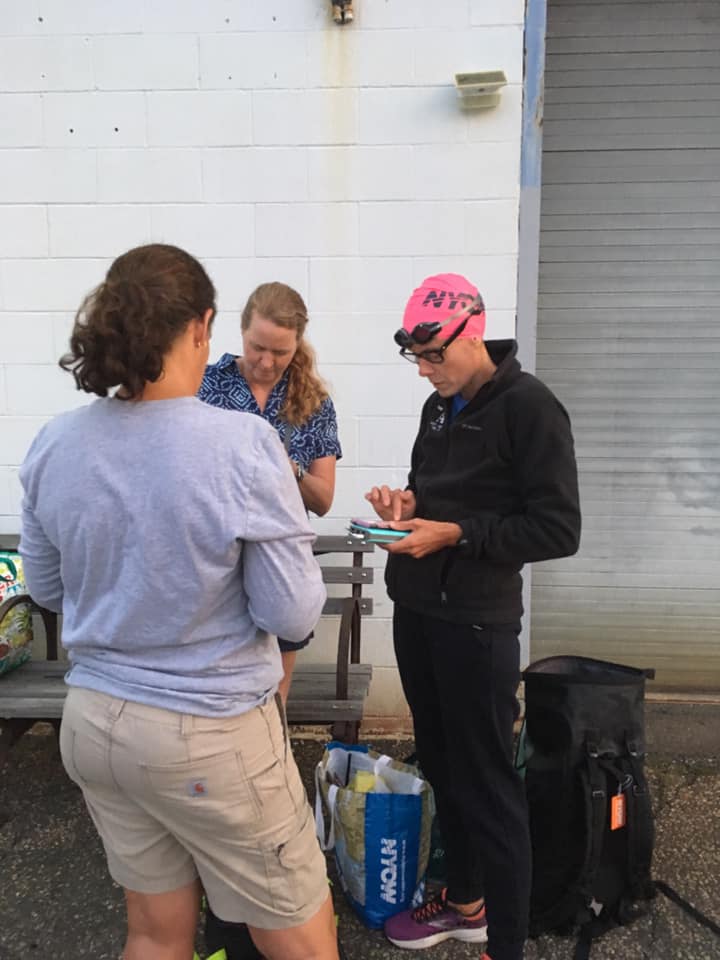
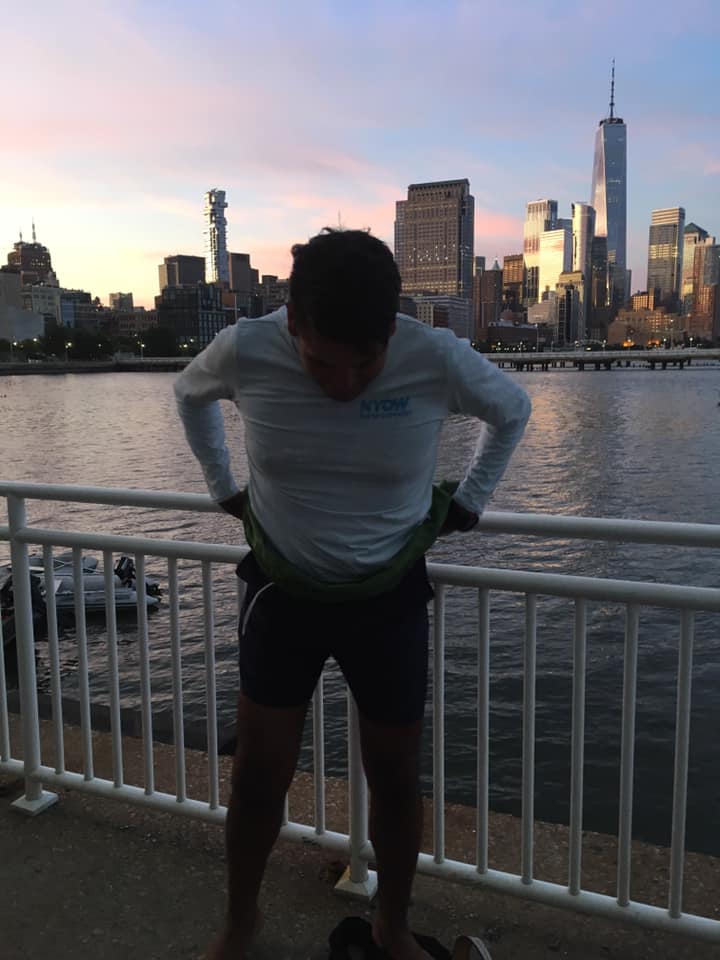


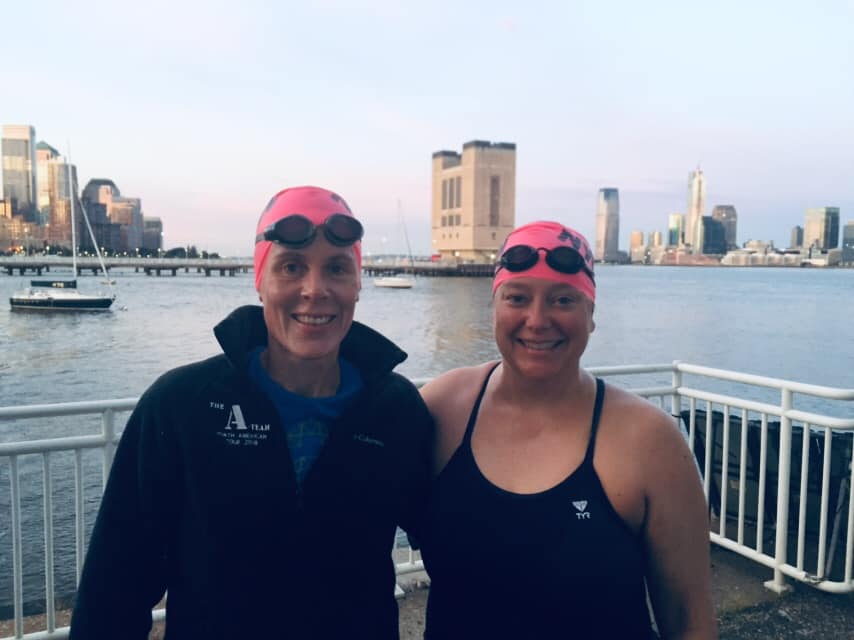

The Swim
The Hudson
We splashed off the Coast Guard pier at the Battery at 6:38 AM. The air was about 60˚F, there were patches of clouds, and the water was comfortable in the low 70s. I started stroking and lost sight of Courtney almost immediately. Alex and Luis soon flanked my sides. The water was calm though there was a brisk northerly wind (about 8 mph). We swam along the seawall against the current and slowly passed the landmarks of the Battery: South Cove, North Cove, and Pier 25. When swimming counterclockwise with the current, it takes minutes to pass these locations in the Hudson’s outgoing ebb. It took 40 minutes to swim the mile upriver to North Cove. The flood current was scheduled to start at 7:15, but it was 8 AM before any northward push was felt. At Pier 40, two miles into the swim, we were 25 minutes behind schedule, and at Pier 88, three miles in, we were forty minutes behind. After that the current picked up and, with the wind against current, it was a choppy, joyful ride upriver. Feeds, consisting of a combination of Gatorade, bananas, Gu gels, mini choc-chip cookies, and ibuprofen every two to four hours, came quickly. I welcomed the bouncy water, since I knew it was due to a fast current push.
After 79th Street Boat Basin, I channeled memories of the past years swimming the the NYC Swim Little Red Light House 10K, which went from 79th St to Inwood, north of the George Washington Bridge. Once that course was covered we moved from the fast currents in the center of the Hudson toward the eastern side of the river close to the Inwood Canoe Club. Club member Manuela Jessel delivered coffee and muffins to Alex and Luis, and Richard Lopez accompanied us through Spuyten Duyvil, the headwaters of the Harlem River.
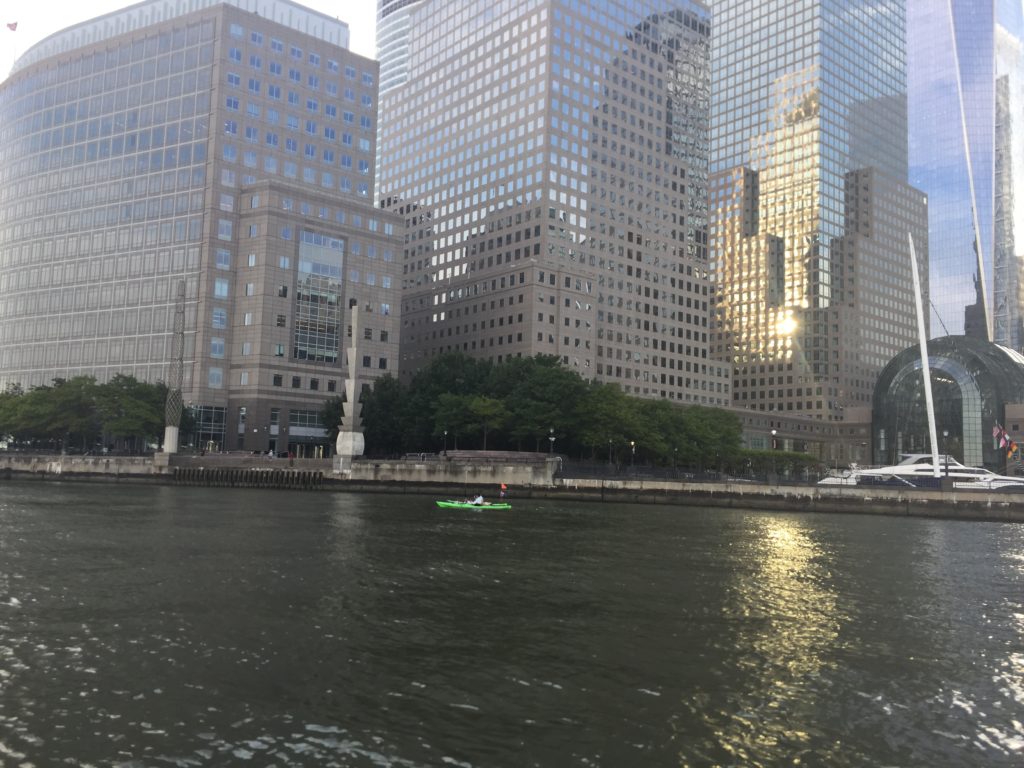
The Harlem
The Harlem River was warm, calm, and sunny and we all let out a whoop of delight to have completed the Hudson after 4.5 hours. I knew that arriving at the Harlem River late meant there would be more time with a push against me on this leg of the course, and it was soon evident that the flood current I was expecting to help me through the first few miles was quickly waning. We arrived in the Harlem at 11 AM and the current turned on or before schedule at 11:55 AM when we were at the 207th Street Bridge, a mere 1.5 miles into the 9 mile stretch. I hadn’t mentally prepared for this scenario and while resting in a lee after Alex and I battled an already brisk current along the eastern sea wall at Roberto Clemente park I said to him “this wasn’t part of the plan”. Alex said “well the plan just changed”. It took an hour to swim another 1.5 miles to High Bridge, all the while the Washington, Alexander Hamilton, and High Bridge overpasses taunted me by looking so near and yet taking so long to reach. I realized the swim could well be over at this point, and if I made it to the East River before her ebb was completed, it certainly wasn’t going to be an 8hr 45 min swim. In any case, it made most sense to keep swimming and see what unfolded.
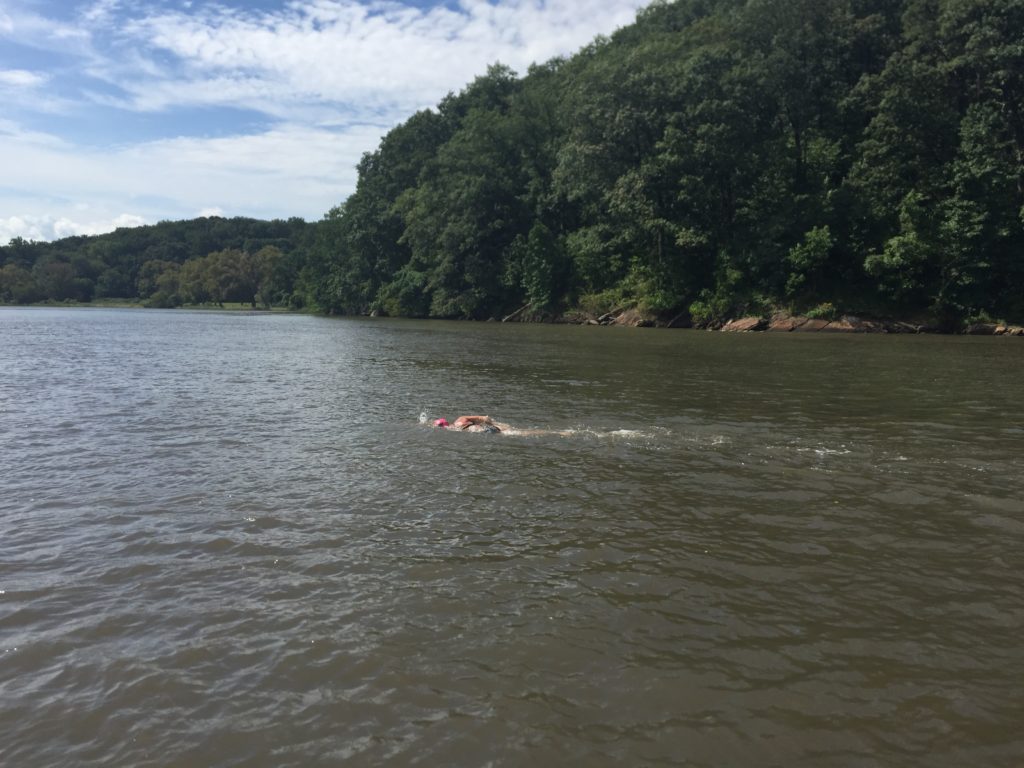
New Yorkers know that by rule of thumb there are 20 blocks to a mile. Luis noted that High Bridge is at 173 Street and the Harlem ends around 100th Street, so it was 3.5 miles more against the current (it’s actually 4.5 miles). With the model now out the window, I calculated I was swimming at about one mile per hour and it would take three hours to swim the remaining 70 blocks of the Harlem. If I got to Mill Rock at 4 PM the swim was finishable, but any later and I would probably not make it down the East River before the end of the outgoing ebb. This is pretty much how things worked out; I was in the Harlem for a total of five hours, arriving at Mill Rock just before 4 PM.
Swimming against the Harlem is the most memorable part of the swim. It’s remaining 11 bridges focused faster waters to flow between the narrowings created by the bridge stanchions. The challenge was to break through these rapid currents and find lees and eddies on the other side of the bridge before encountering the next bridge challenge. Hannah Borgeson, who observed Liz’s swim in 2009, warned me that the narrow channels under the bridges nearest the sea wall had even faster currents that the central channels. Each bridge was a puzzle to solve. Luis and Alex focused hard on the best course to take and I followed their direction, sometimes moving left, then right, and sometimes half way in, turning back and trying a different channel.

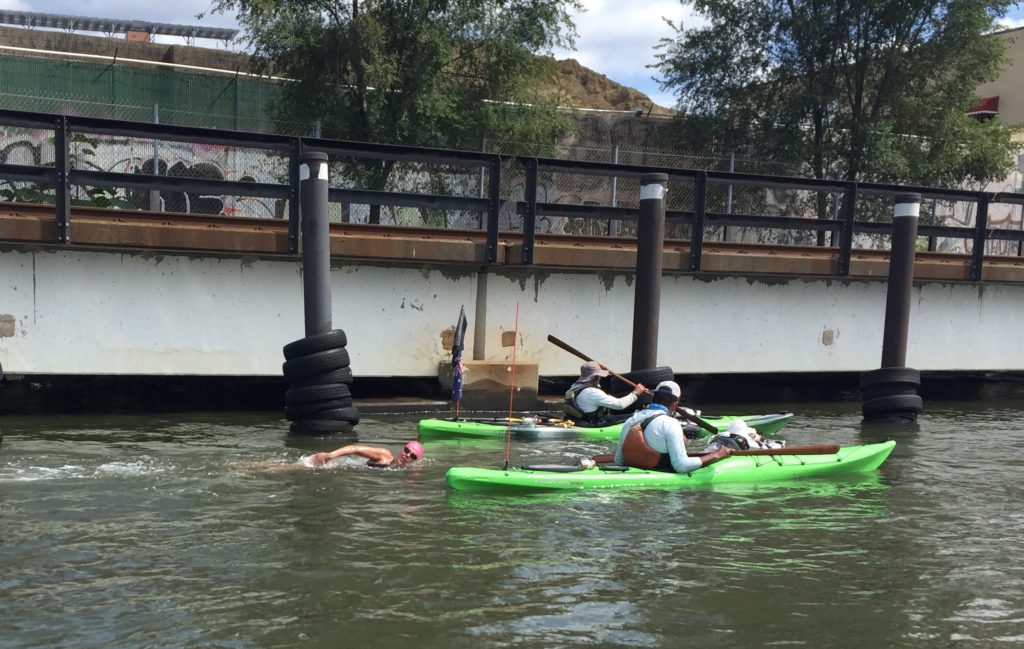

About half-way through the Harlem, near the Madison Avenue Bridge, friend Sharon Gunderson joined us on a stand-up paddle board. I had wanted Sharon to be on the boat for the swim, but she had other plans, so I was beaming that she could join us, and even better that she was right on the water with me. She radiated warmth, support, and calm. I swam with a smile, so happy to be surrounded by this wonderful team who were helping me on this crazy venture, which as the hours passed and we struggled through more and more of the bridge currents, struck me as being a really bad idea.
Soon Sharon was leading the charge, scouting out the best channels to take under the bridges. The challenges mounted as we passed the Third Ave, Willis Ave, and RFK/Triboro Bridges. I had been warned there was no hiding from adverse currents at the RFK Bridge, though Sharon made the pass relatively easy (even if it was over submerged dock pilings). And there was a jumper just before we went under this bridge, which should have registered from all the flashing police car lights, but I only learned this later, and that the “patient” was ok.
The river broadened and I could see friendly and familiar landmarks of the Hell Gate Bridge and the 103rd Street footbridge. Excitement mounted within that the swim could be completed. At Wards and Randall’s Island we passed under a Ferry dock being repaired to avoid the wash of a NYPD launch pushing against the dock at full throttle. The loud beats and flashing lights of the massive Electric Zoo rave soon serenaded us. Luis and Alex rocked their boats and waved their paddles as they grooved to the beat. It was hysterical. People on the shore looked and pointed at us and it felt like we were in an alternate universe to them. After eight hours of challenging swimming and the intrusion of the city on our tired delirium, the dancing kayakers captured the craziness of this venture.
I hoped see Andy and my kids around this time and they appeared almost miraculously when I stopped to feed before the 103rd street footbridge. It was all smiles at this point. They walked with us as we swam against the current by the rip rap on Randall’s island. Under the footbridge Alex, Luis and I shrieked as signs of the favorable ebb current of the East River were felt. Andy and the kids had to run to keep up with us now and soon we were waving good-bye.
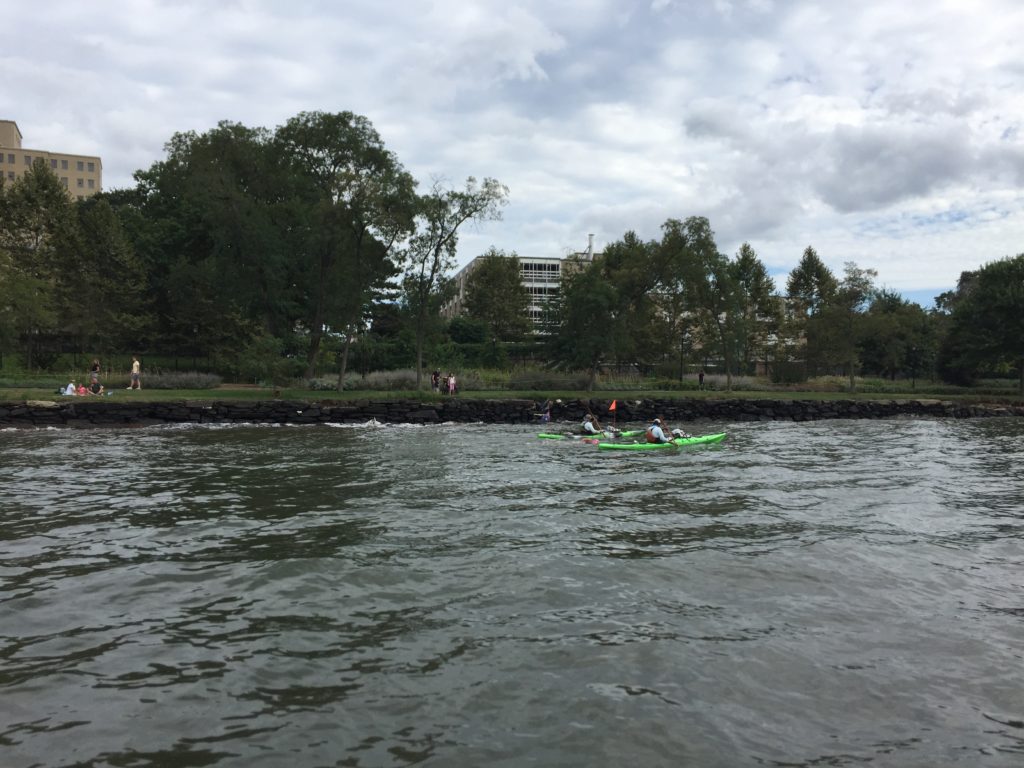
The East River
Breaking into the East River ebb was no easy feat. We tried to enter at the tip of Randall’s island, on the east side of Mill Rock, but had to turn back and pass Mill Rocks west bank. At this tidal confluence the water ripped, twisted, turned and sucked. There was small tight chop and then bigger chop. At one point Luis’ kayak was swung 90˚ in seconds and his stern almost whacked me in the head. We all knew to hang on and go with the flow, for the final eight miles would take not much more than an hour to complete in the 3-5 knot currents.
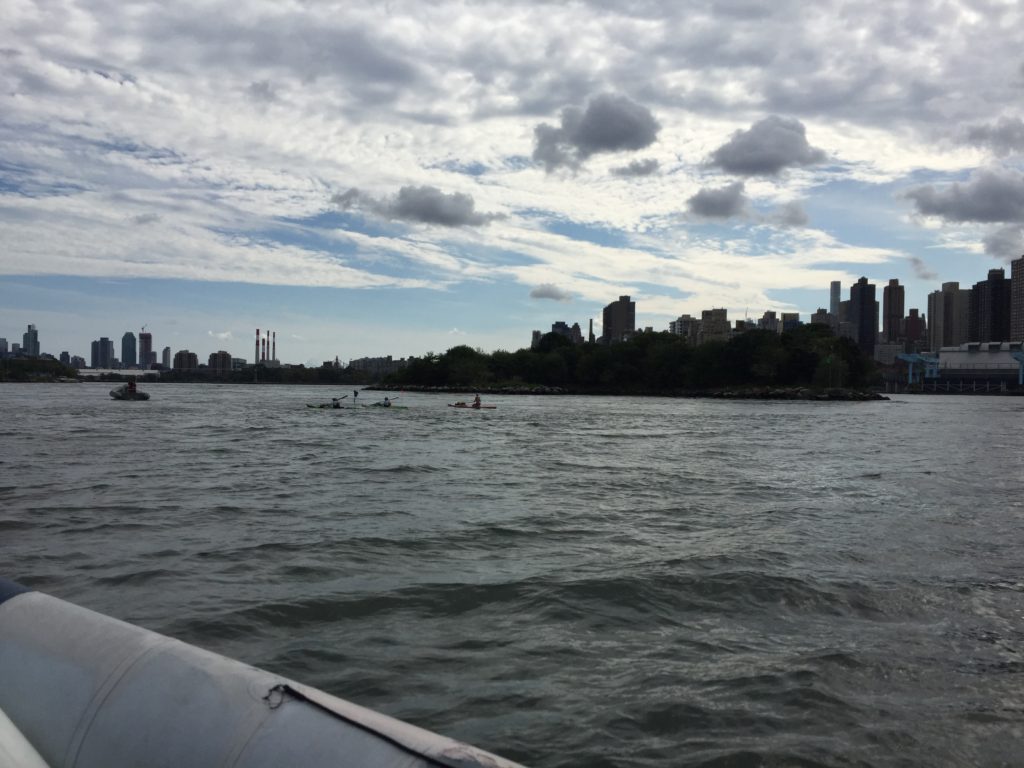
As we entered the East River I was preparing for the loss of Sharon from the team as I assumed she would return to her launch site in the Harlem. However, as we bounced and twisted in the wild flow, she was there by my side, kneeling upright on her paddle board. Imagine someone keeping their balance while standing on a wild bull at a rodeo; Sharon’s yoga master and ladder skills from painting houses were shining through. (I have also watched Sharon paint my apartments ceiling while balancing on one leg on the top wrung of a ladder).
Along Roosevelt Island, where the currents are strongest, we had five foot swells and breaking waves. Momentarily we’d disappear from each-others view while riding over a wave crest or into a trough. We all howled in delight; after the Harlem river what a contrast and reward.
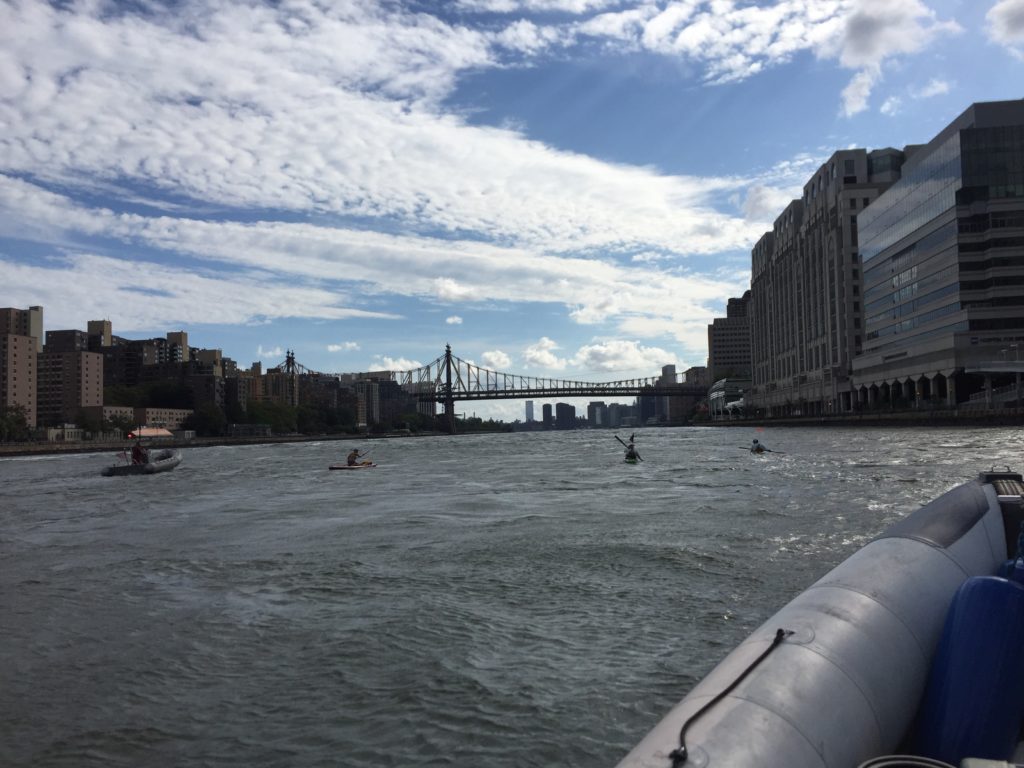
Approaching 34th street the Sun was starting to dip in the sky and cast its glow our way. It felt like the four of us were a formidable, misfit gang cruising down the East River. We flew past the the BMW bridges, but this time in reverse: Williamsburg, Manhattan, Brooklyn. At the heliport I could see the silhouette of the burnt orange Staten Island Ferry docking at the finish point with the Statue of Liberty in the background.
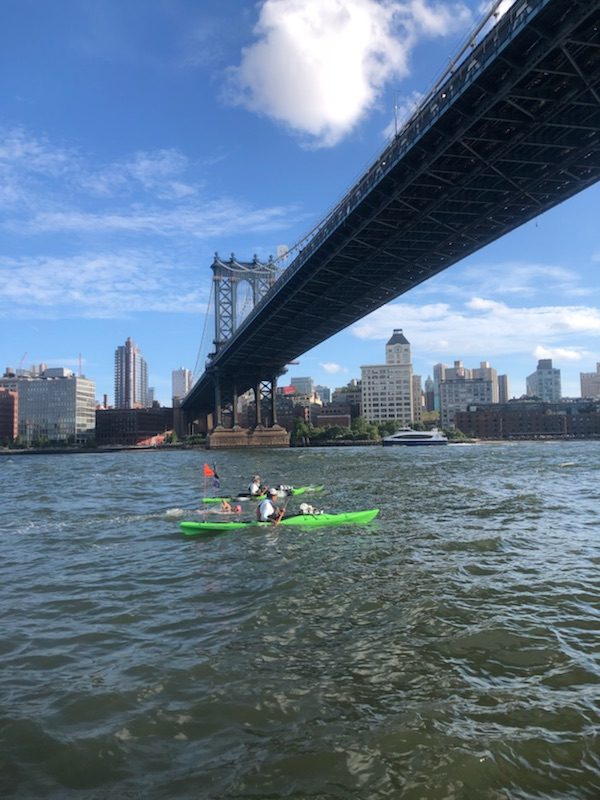
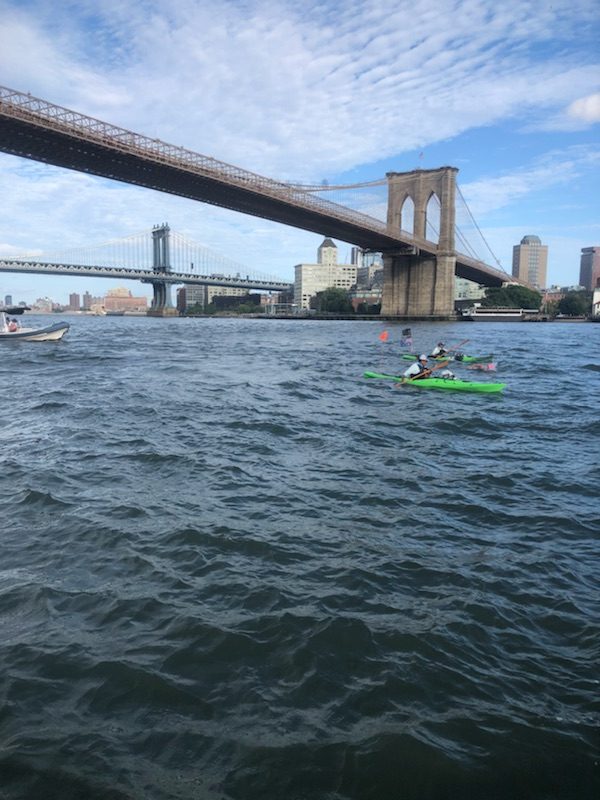
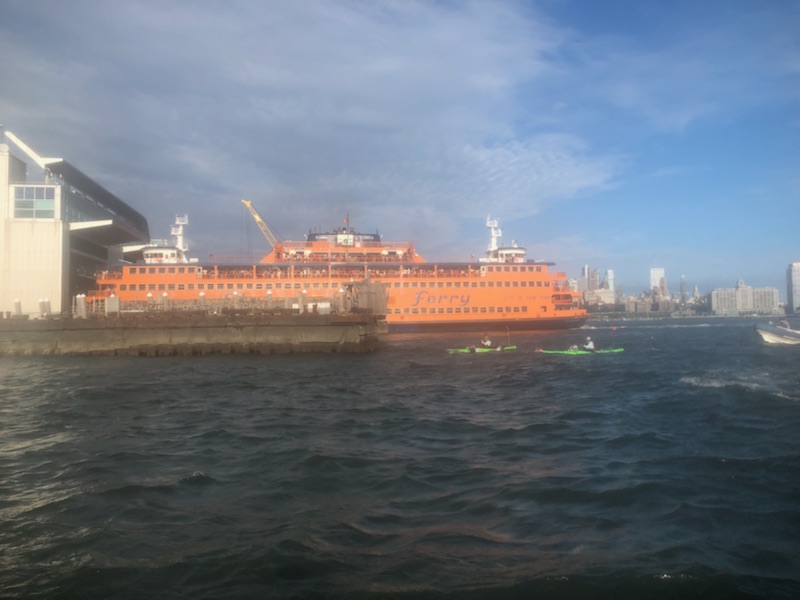
Would we need to wait for the ferry to depart? Luis told me to keep swimming. Sean had spoken to the ferry captain and they were holding while I passed the terminal. Passengers were standing at the railings watching me. New York City casts rare and absurd moments when we stop and realize why we love this city. This was one of them. My final time was 11 hours and 17 seconds; forty four minutes faster than the former record and forty minutes ahead of the flood in the East River that would have stopped me in my tracks. I climbed on the RHIB to the embrace of Janet and Dana, elated.
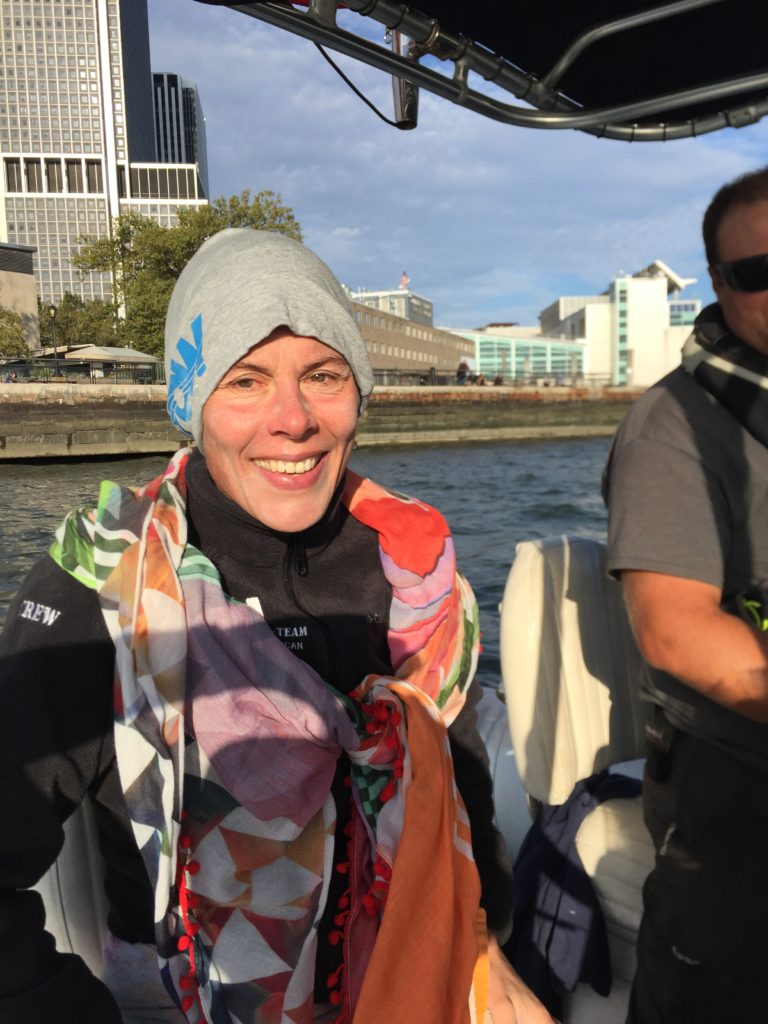
Final Thoughts
All the people mentioned in this write up were part of my team that helped to accomplish this goal. Their vast experience and support is the reason this day was so fun, relaxed, a wonderful experience, and ultimately a success. I am so grateful. As I said to Alex and Luis after riding the white waters along Roosevelt Island “You guys are my heroes. I can’t thank you enough”.
What Happened to Courtney?
Courtney lost valuable time in the Hudson’s flood current when she was forced to move to shore and tread water for 30 minutes while a French war ship docked. She arrived at Spuyten Duyvil with the Harlem against her, and battled the river at Broadway Bridge for many hours until retiring after 11 hours of swimming.

